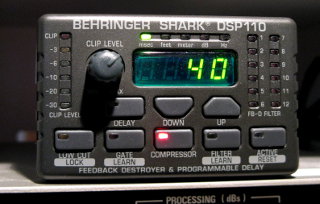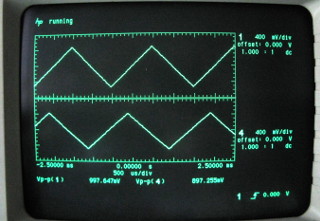<HOME
<OH2GVB
Behringer Shark DSP110 / FBQ100 Notes
Does its compressor actually work? Yes it does!
(TL,DR: Yes, the compressor does work.)
Ages ago I acquired a used Behringer Shark DSP110 Signal Processor,
hoping to use it as a compressor on my radio station. Nowadays the same
device goes by the model number FBQ100. Cheesy as it is to describe
it as an audio "Swiss army knife", that's really the best
description. It contains in one compact and relatively cheap box:

|
- A microphone preamp with gain control, also providing +48 V
phantom power
- An effective low-cut filter and noise gate—these can
make a cheap wireless mic sound much better
in a PA application!
- An adjustable delay line up to 2.5 s—besides being
highly annoying, it could be used together with an analog processor
to obtain "zero attack time" compression
- Conversion between mic and line levels either way, as well as
unbalanced to balanced conversion like a "DI box". The
balanced output is symmetric, so in an emergency, it can even be used
to drive a stereo amplifier in "bridged" mode by splitting
the "HOT" and "COLD" signals to the left and
right inputs.
- Automatically adjusting feedback destroyer filters—not really
useful for ham radio (or perhaps they could be used in
RX audio when someone
is tuning on your frequency), but they are somewhat effective in PA
use. Nothing magical, though—place the mic directly infront of a
loudspeaker, and you will get feedback, filters or not...
- And, finally, a compressor function, which doesn't seem to
do anything... Or does it?
|
The compressor seemed totally ineffective—I could hear no difference
between compressed and uncompressed output, even with aggressive
attack/release times and maximum compression (or "density" as it's
called in the manual). But, on the other hand, it did not produce any nasty
artefacts either. Was it actually doing anything? Whereas all the other
functions of this device are adequately described in the minimalist manual,
I found it rather lacking in the compressor section.
From the manual it is easy to understand that the
"CLIP LEVEL" adjustment would only be used to match
the analog input and output levels to the dynamic range of the 24-bit DSP.
The warning not to let the "CLIP" LED light up makes
sense, as overdriving the A/D converter would certainly cause awful
distortion. So that's how I adjusted it, making sure it never, ever clips.
But should it be clipping for the compression to work?
To find out, I fed a 500 Hz tone (in normal human speech, the
power spectrum peak is close to 500 Hz) into my DSP110 and
into one channel of my oscilloscope, and monitored the output of the
DSP110 on another channel of the 'scope. I used a triangular
waveform, as any clipping will show up clearly. I then varied the amplitude
of the input signal and the setting of the "CLIP LEVEL"
adjustment, and observed the output. All other
features of the DSP110 were disabled. The input and output were
unbalanced, via 6.35 mm mono phone plugs, using
"LINE" or "+4 dBu" levels
(at which setting the "MIC GAIN" control has no
effect).

|
Here's what the input and output signals looked like with the compressor
fully off (i.e. the "density" set to zero) and the
"CLIP LEVEL" adjusted low enough so that only two LEDs
light on the bargraph (i.e. an indication of −20). There's a
phase difference between input and output due to a small propagation delay
in the DSP110. The peak-to-peak amplitudes are almost identical
for the input signal (upper, Channel 1) and output (lower,
Channel 4).
As I adjusted the "CLIP LEVEL" control counterclockwise
(i.e. to a lower level), pretty much nothing happened on the 'scope
display as the bargraph advanced to its full indication of six LEDs,
including the red "CLIP" LED. So the
"CLIP LEVEL" control appears to decrease output gain
after the DSP as much as it increases input gain before it, with
no net effect when the compressor function is disabled.
|

|
Here's what happened as soon as I advanced the
"CLIP LEVEL" control slightly further—clipping
became evident in the output signal. And this
is hard clipping, caused by exceeding the dynamic range of the
A/D converter's input. This
is what you do not want in your audio, regardless whether it's
PA, ham radio, broadcast or recording.
Next I activated the compressor. That caused the overall level of the output
signal to be reduced (that's what compressors do), but whenever the
"CLIP LEVEL" control was advanced past the position
where the red "CLIP" LED lights (and that position was
not affected by the compressor setting), the same hard clipping was
seen on the
output waveform. So whether or not you use the compressor function, under
no circumstances do you want the "CLIP" LED to light!
So yes, the manual is correct about that! How about the compresion, then?
How come it's not doing anything?
|

|
Well, actually, it is doing plenty! You just can't hear any artefacts,
because it really is that good! (Well, I'm a ham radio operator, not
a hi-fi enthusiast. So since my tin ears can't even discern between
44.1 kHz 16-bit audio and 192 kHz 24-bit, you may not actually
want my opinion.)
I used the same setup as above, but
with a sine wave this time, and I measured the amplitudes at the input and
output at different compressor settings (with a 1 s attack/decay time,
but varying the "density" parameter) and different input signal
amplitudes. Here are my results, as
a plot of output signal against input
signal at various settings of the compressor "density". There's
plenty of compression going on! Interestingly, this compressor actually
increases the signal amplitude when it is low, in addition to
decreasing it at high levels (as normal analog compressors do). But note,
however, that there is no output gain control to make up for the
reduced output levels at high compression—the output volume will always
be significantly lower at high compression, so you'll need to
compensate for that afterwards in your mixer or amplifier.
It also seems that compression levels ("densities") of
60–100 are pretty much the same, so the actually useful adjustment
range is about 20–60. The point where all
"density" settings produce the same output is about where
the "−30" indication on the bar graph lights up—above
that the signal levels are reduced as in a normal analog compressor, but
below that signals are actually amplified somewhat.
|

|
Finally, I wanted to assess how the attack/decay setting (called
"speed" in the manual, despite the unit being ms) affects the
compression, but my ancient HP
digital oscilloscope was just not up to the task of measuring the
low-frequency envelopes of high-frequency signals. (It would have been
a breeze for my newer Siglent,
which I did not have at the time.) But using a 3 kHz
sine wave, modulated stepwise in amplitude, I was able to see the onset
of compression at the smallest setting of 10 ms.
This is the output waveform,
reacting to a stepwise amplitude increase at the left edge of
the trace. The time markers show a 10 ms period, after which the
level has almost settled, but the initial overshoot within that 10 ms
is clear enough. Obviously this device is not even trying to provide
"zero attack time" compression.
|
So, in conclusion, this little box does, in fact, do everything it advertizes.
Including compression. It does in DSP almost the same thing that
analog processors do, and it does it actually very well. Too bad there's no
output "make up" gain control to increase output amplitude
after compression, but that can be compensated for in later stages. For PA
use I think the device is fine overall, but I still wouldn't recommend it
for ham radio, broadcast or recording use, because the controls aren't
very versatile—it's more suited for quick setup than fine tuning.
Surprisingly, this DSP processor does not even try to
provide "zero attack time" compression, which is difficult to
do with purely analog means, but which I would have thought relatively
easy with DSP (or maybe I'm simply wrong). But that can be achieved by
using the DSP110 as a delay line, together with an analog compressor:
Feed the audio into the compressor's sidechain directly, but into its
audio input through the DSP110. Then use the DSP110's
delay function (set to approximately the attack time of the analog
compressor, or slightly more) to allow the compressor to act before
the actual audio arrives.
Antti J. Niskanen <uuki@iki.fi>




